For individuals with a partial foot amputation, walking can feel completely different than before. The loss of part of the foot changes how weight is distributed, how balance is maintained, and how movement feels with every step. It can lead to discomfort, fatigue, and even pain in other parts of the body as muscles and joints work harder to compensate.
Traditional prosthetic solutions help restore some function, but they often lack the ability to return energy with each step. This is where energy storage and return (ESR) prosthetics make a huge difference. These advanced prosthetic designs absorb the impact of movement and release that stored energy to create a natural, more powerful push-off. This helps users walk more efficiently, feel less fatigued, and regain confidence in their mobility.
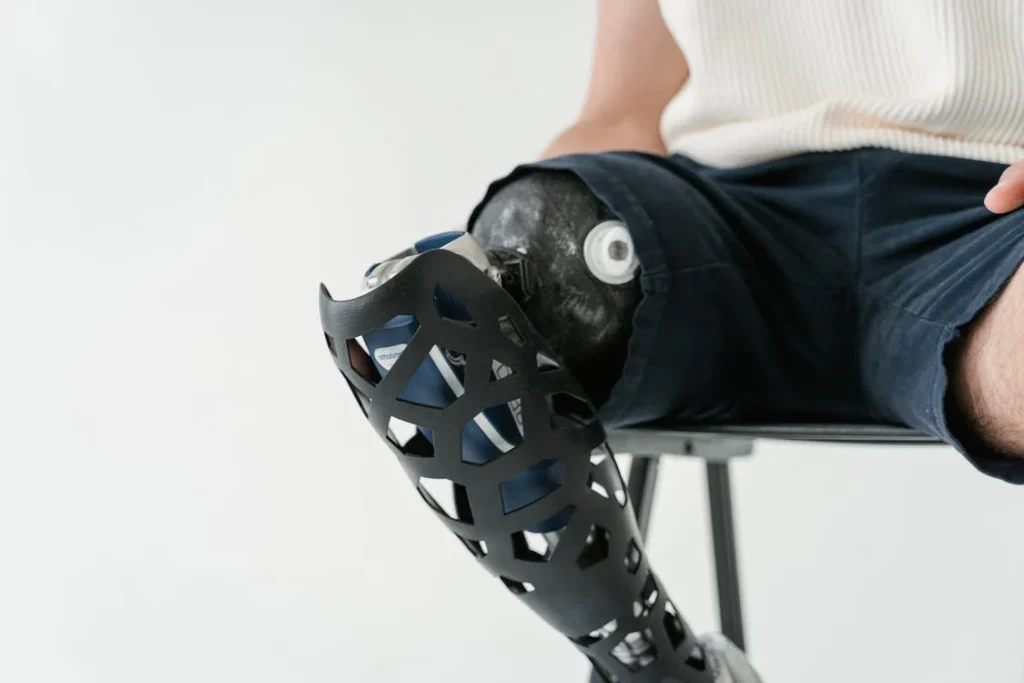
Understanding Energy Storage and Return (ESR) Prosthetics
How ESR Technology Works
Energy storage and return prosthetics are designed to mimic the natural movement of the foot by absorbing and releasing energy with each step. When a person walks, their foot naturally stores energy when it makes contact with the ground and then releases it as they push off for the next step.
For individuals with a partial foot amputation, this mechanism is disrupted, making movement feel less natural and more physically demanding.
ESR prosthetics solve this problem by using specialized materials, such as carbon fiber, that act like a spring. When the prosthetic foot touches the ground, it compresses slightly, absorbing energy.
As the user shifts their weight forward, the prosthetic releases that stored energy, creating a push-off effect. This process helps reduce the effort required for walking, making movement smoother and more efficient.
Unlike traditional prosthetics, which simply provide support, ESR prosthetics actively assist with motion. This can be especially beneficial for individuals who lead active lifestyles, as it allows for greater mobility, stability, and comfort.
The technology ensures that each step feels more natural and less physically taxing, helping to restore confidence in movement.
Why Partial Foot Amputees Need Advanced Support
Partial foot amputations involve the removal of toes, the forefoot, or parts of the midfoot, significantly altering the way weight is distributed across the foot. Because the foot is responsible for absorbing shock, providing balance, and generating force for movement, even a small loss of structure can have a major impact.
Many individuals experience instability, discomfort, and additional strain on their residual limb.
Without proper prosthetic support, the body compensates by shifting weight differently, which can lead to pain in the knees, hips, and lower back.
This compensation can also increase the risk of long-term joint issues and muscle imbalances. ESR prosthetics help restore proper biomechanics by mimicking the natural movement of the foot, reducing strain on other parts of the body.
For many partial foot amputees, traditional prosthetic options do not provide the flexibility and energy return needed for a natural gait. Some solutions, such as rigid footplates or shoe inserts, may help with balance but fail to restore lost motion.
ESR prosthetics, on the other hand, provide both structure and dynamic movement, allowing for better weight distribution and a more responsive walking experience.
Improving Mobility and Reducing Fatigue
Walking with a partial foot amputation can require more effort because the body must work harder to compensate for the missing portion of the foot. This can lead to increased fatigue, making even short distances feel exhausting.
Over time, this can discourage individuals from staying active, which can affect overall health and well-being.
ESR prosthetics reduce this extra effort by providing a spring-like effect that propels the user forward. This not only makes walking feel easier but also reduces energy expenditure.
By assisting with movement, these prosthetics allow users to walk longer distances, engage in physical activities, and maintain an active lifestyle without excessive strain.

Restoring Natural Movement and Balance
Enhancing Stability and Posture
One of the biggest challenges for partial foot amputees is maintaining balance. The foot plays a crucial role in stabilizing the body, distributing weight, and ensuring smooth transitions between movements.
When part of the foot is missing, the body has to adjust by shifting weight differently, which can lead to instability, uneven posture, and an increased risk of falls.
Energy storage and return prosthetics help restore balance by providing a more even weight distribution. Because they absorb and release energy with each step, they allow for a smoother and more controlled movement pattern.
This means less stress on the residual limb and a reduced risk of developing joint pain or muscle strain over time.
Proper posture is also easier to maintain with ESR prosthetics. When weight is distributed more naturally, there is less need to compensate by leaning forward or shifting to one side. This leads to better spinal alignment, reducing pressure on the lower back and hips.
Over time, users notice improved comfort and greater ease in standing and walking for extended periods.
Supporting an Active Lifestyle
Many partial foot amputees worry about whether they will be able to return to the activities they once enjoyed. Whether it is walking long distances, jogging, or simply moving around without discomfort, having the right prosthetic can make all the difference.
ESR prosthetics provide the flexibility and responsiveness needed to support various levels of activity, from daily movement to high-impact sports.
Unlike rigid prosthetic solutions, which can limit motion, ESR technology adapts to different surfaces and movement patterns. This means users can walk on uneven ground, navigate inclines, and move confidently without worrying about discomfort or instability.
The energy return mechanism makes it easier to maintain momentum, which is especially helpful for those who want to stay active without excessive fatigue.
For individuals who engage in sports or physical fitness, ESR prosthetics offer additional advantages. The responsive nature of these devices allows for quicker movements and better shock absorption, reducing the risk of strain on the residual limb.
Many users find that they can gradually return to running, hiking, or other forms of exercise with greater ease and confidence.
Reducing the Risk of Secondary Health Issues
Without proper support, partial foot amputees are at risk of developing secondary health issues due to altered movement patterns. When the body compensates for the missing portion of the foot, it can put extra stress on other joints, leading to conditions such as knee pain, hip misalignment, and lower back problems.
ESR prosthetics help prevent these issues by promoting a more natural gait. When the prosthetic foot absorbs and releases energy effectively, there is less impact on the joints, reducing wear and tear over time.
This means a lower risk of developing chronic pain or mobility limitations in the future.
By restoring balance, improving movement efficiency, and reducing strain on the body, ESR prosthetics help users maintain long-term health and independence. The benefits extend beyond mobility, contributing to overall well-being and a better quality of life.
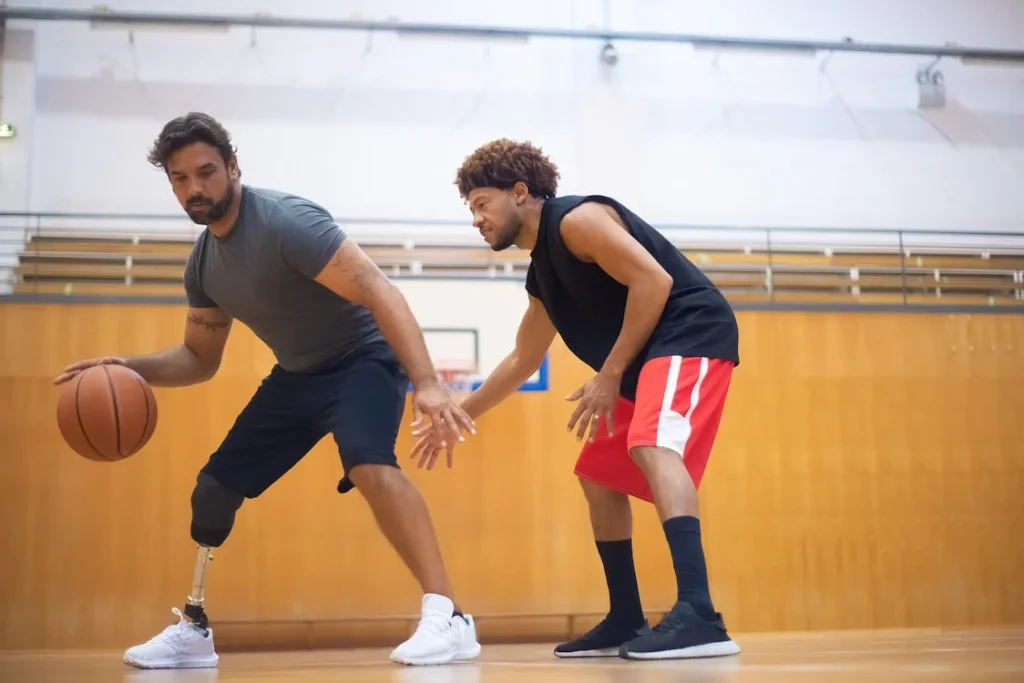
Psychological and Emotional Benefits of ESR Prosthetics
Restoring Confidence in Movement
For many partial foot amputees, one of the biggest struggles is not just the physical challenge of walking but the fear of instability, discomfort, or falling.
When movement does not feel natural, it can create hesitation and self-doubt. Many individuals avoid certain activities or social situations because they feel uncertain about their ability to move freely and comfortably.
Energy storage and return prosthetics help restore confidence by providing a stable, dynamic walking experience. Because these prosthetics absorb impact and release energy efficiently, users feel more secure with every step.
The ability to walk smoothly and naturally reduces the fear of tripping or losing balance, allowing individuals to move with greater ease in everyday situations.
Feeling in control of movement is a major factor in rebuilding self-assurance. Whether it is walking across a room, going for a stroll in the park, or returning to a favorite activity, ESR prosthetics give users the ability to engage in life more fully.
The reassurance that movement will be steady and predictable allows for a renewed sense of independence.
Reducing Social Anxiety and Isolation
Many partial foot amputees experience changes in their social lives after amputation. Some may feel self-conscious about their mobility, while others worry about how others will perceive them.
This can lead to avoiding social events, limiting interactions, and feeling isolated. Over time, this emotional struggle can be just as challenging as the physical adjustments.
ESR prosthetics help address these concerns by making movement feel more natural and less restrictive.
When individuals feel secure in their ability to walk and engage in activities, they are more likely to participate in social gatherings, family outings, or community events. The focus shifts away from mobility limitations and back to enjoying interactions with others.
Many users report that once they become comfortable with their ESR prosthetic, they stop thinking about their movement as much. The smoother, more effortless gait allows them to be more present in conversations and experiences, rather than being preoccupied with how they are walking.
This shift in mindset helps reduce anxiety and makes social engagement feel more natural.
Encouraging an Active and Fulfilling Life
A key part of emotional well-being is the ability to live life on one’s own terms. Many partial foot amputees worry that they will have to give up activities they once enjoyed, whether it is a favorite sport, an outdoor hobby, or simply taking daily walks without discomfort.
The right prosthetic solution plays a crucial role in determining how much freedom of movement an individual can maintain.
ESR prosthetics open up more opportunities for staying active by reducing effort and strain during movement. When walking feels easier and more natural, individuals are more likely to stay engaged in physical activity.
This not only improves overall health but also contributes to emotional resilience and a sense of purpose.
Many users find that as they regain strength and mobility, they begin setting new goals. Whether it is increasing walking distance, participating in community fitness events, or even trying a new activity, the ability to move with confidence leads to new possibilities.
Over time, this sense of progress helps individuals redefine what is possible for their future.
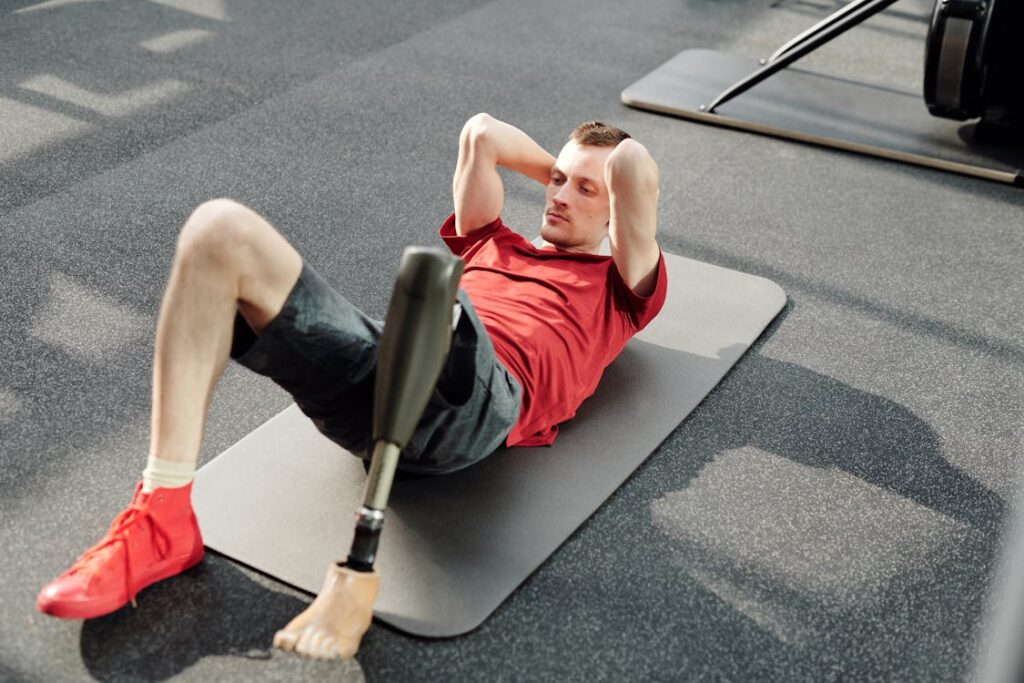
Choosing the Right ESR Prosthetic for Partial Foot Amputation
Understanding Different ESR Prosthetic Designs
Energy storage and return prosthetics come in different designs, each suited to various levels of activity and amputation types.
For partial foot amputees, the choice of prosthetic depends on the specific part of the foot that has been removed, daily mobility needs, and personal goals.
Some prosthetic designs focus on providing stability for everyday walking, while others are built for high-energy activities such as running or sports.
The materials used in ESR prosthetics also play a key role in functionality. Many are made from carbon fiber due to its lightweight and highly responsive nature.
This allows the prosthetic to flex and return energy efficiently, creating a smoother walking experience. Some models integrate cushioning materials to reduce pressure on the residual limb, helping to prevent discomfort or skin irritation.
For those who have lost only a portion of the foot, there are specialized ESR prosthetic designs that work within footwear, providing hidden support while maintaining a natural appearance.
Others are externally fitted, offering a more structured design that enhances balance and movement. The right choice depends on individual preferences, lifestyle demands, and the recommendations of a prosthetist.
Factors to Consider When Selecting an ESR Prosthetic
Comfort is one of the most important factors when choosing a prosthetic. Since partial foot amputees still have a portion of their natural foot, the prosthetic must work in harmony with the residual limb.
A poorly fitted device can cause pressure points, leading to pain and discomfort. Working closely with a prosthetist ensures that the fit is optimized for maximum comfort and functionality.
Durability is another crucial aspect. Since the prosthetic foot must withstand daily wear and absorb repeated impact, choosing a high-quality, long-lasting material is essential.
Carbon fiber and reinforced composite materials offer durability while maintaining flexibility. Investing in a well-built ESR prosthetic reduces the need for frequent replacements and ensures consistent performance over time.
Lifestyle and activity level also influence the selection of an ESR prosthetic. Those who lead an active lifestyle may benefit from a more dynamic model that provides maximum energy return and responsiveness.
Individuals who require a prosthetic for everyday movement may prioritize stability and ease of use. Consulting with a prosthetist helps determine the best balance between performance and practicality.
The Role of Rehabilitation and Adaptation
Once an ESR prosthetic is selected, the process of adaptation begins. Adjusting to a new prosthetic takes time, and proper rehabilitation plays a critical role in ensuring long-term success.
Physical therapy helps individuals strengthen their muscles, improve coordination, and develop confidence in their movement.
Initially, walking with an ESR prosthetic may feel different, especially for those who have spent a long time compensating for their missing foot. However, with guided practice, the body adapts to the new movement patterns.
Many individuals experience a significant improvement in mobility within weeks of consistent use.
Gamified rehabilitation programs, such as those offered by Robobionics, make this transition more engaging. By incorporating interactive exercises and challenges, these programs help users develop better control over their prosthetic while keeping the recovery process enjoyable.
This approach encourages consistent practice, leading to faster adaptation and greater confidence in daily movement.
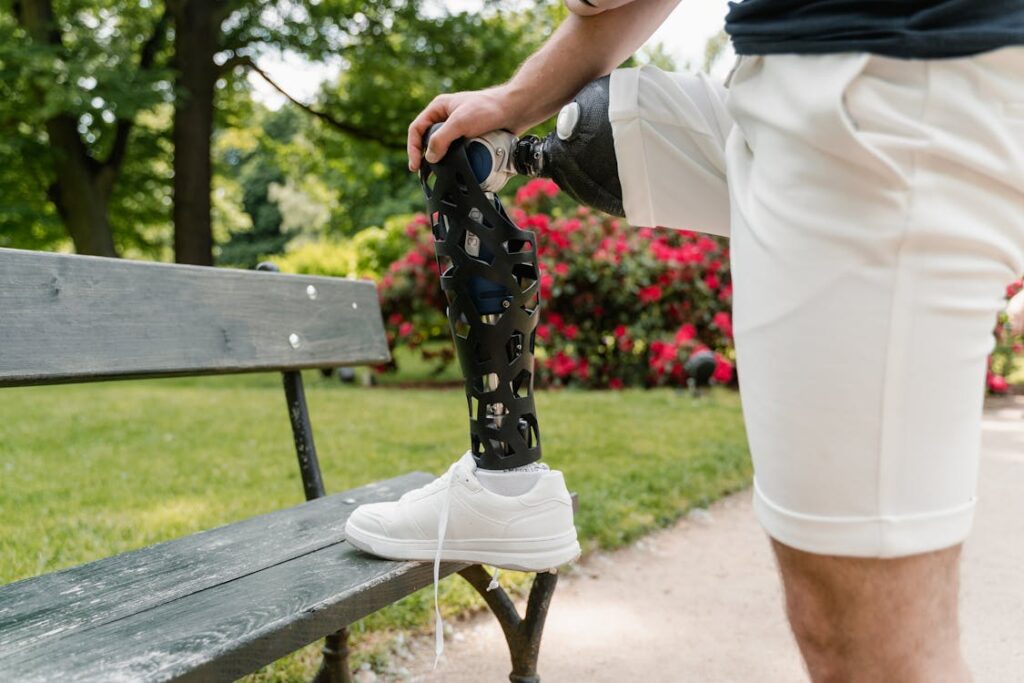
Long-Term Benefits of ESR Prosthetics for Partial Foot Amputees
Improving Long-Term Joint Health
One of the most overlooked aspects of partial foot amputation is the long-term strain it places on the rest of the body. When the foot loses its natural ability to absorb shock and push off properly, the body compensates by shifting weight unnaturally.
Over time, this compensation can cause excessive stress on the knees, hips, and lower back, leading to joint pain, misalignment, and even degenerative conditions.
Energy storage and return prosthetics help reduce these issues by restoring a more natural walking pattern. The spring-like effect of the prosthetic absorbs impact forces and redistributes them, reducing the burden on other joints.
This means less strain on the body, which helps prevent long-term pain and mobility limitations. Many users find that with consistent use of an ESR prosthetic, they experience fewer aches and pains, allowing them to stay active for years to come.
Enhancing Endurance and Physical Fitness
One of the biggest challenges for partial foot amputees is maintaining stamina while walking. Because movement requires more effort after amputation, many individuals find themselves getting tired more quickly than before.
Fatigue can make it difficult to complete daily tasks, limit participation in recreational activities, and even impact mental well-being.
ESR prosthetics help conserve energy by providing a forward-propelling motion with each step. Instead of relying solely on muscle strength to move forward, the prosthetic assists in generating momentum.
This reduces the effort required for walking, allowing users to move longer distances without feeling exhausted. As endurance improves, individuals are more likely to engage in physical activities, leading to better overall fitness and a healthier lifestyle.
Many users report that after adapting to an ESR prosthetic, they can return to activities they once thought were impossible.
Whether it is walking through a shopping mall without needing frequent breaks, taking a hike, or even participating in adaptive sports, the increased energy efficiency of ESR prosthetics opens up a world of possibilities.
Increasing Independence and Quality of Life
Regaining independence is one of the most significant emotional and practical benefits of using an ESR prosthetic.
Many partial foot amputees initially struggle with a loss of autonomy, as daily activities such as walking long distances, climbing stairs, or standing for extended periods become more challenging.
This can lead to frustration and even a reluctance to participate in social or professional activities.
With an ESR prosthetic, movement becomes more fluid and natural, making it easier to navigate everyday life.
Individuals find that they no longer have to think about every step or worry about discomfort, which gives them the freedom to focus on their goals and interests.
The ability to move confidently and without excessive fatigue leads to a greater sense of control over one’s life.
Whether it is returning to work, traveling, or simply enjoying time with family and friends, having a prosthetic that restores mobility plays a crucial role in maintaining a fulfilling lifestyle.
The right ESR prosthetic does more than just improve movement—it helps individuals reclaim their independence and confidence.
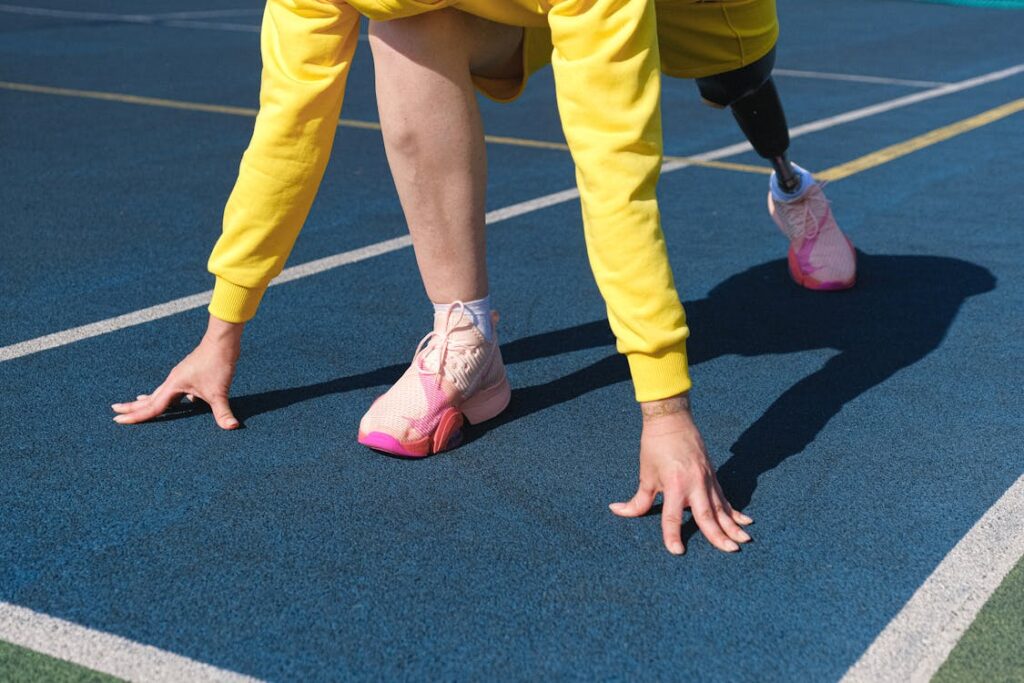
The Future of ESR Prosthetics for Partial Foot Amputees
Advancements in Prosthetic Technology
The field of prosthetics is constantly evolving, and energy storage and return technology is becoming more advanced with each innovation.
Manufacturers are now designing prosthetics that not only replicate natural movement but also enhance it.
With the use of lightweight, high-performance materials like carbon fiber and advanced polymers, ESR prosthetics are becoming more efficient, durable, and responsive than ever before.
One of the most exciting advancements is the integration of smart prosthetics, which use sensors and microprocessors to adapt in real time to different walking surfaces and activity levels.
These intelligent prosthetics can adjust stiffness, energy return, and support based on the user’s movement, making transitions between activities smoother.
This allows for greater adaptability, whether walking on uneven terrain, climbing stairs, or moving quickly from one place to another.
Another major improvement is in the customization of prosthetics. With 3D printing and personalized scanning technology, prosthetists can create devices that perfectly match the user’s anatomy and movement patterns.
This ensures a more comfortable fit, better weight distribution, and improved energy efficiency, all of which contribute to a more natural walking experience.
The Role of Rehabilitation in Maximizing Prosthetic Benefits
While advancements in ESR prosthetic technology are making movement easier, rehabilitation remains a crucial part of the process. No matter how advanced a prosthetic is, the user must learn how to integrate it into their daily routine effectively.
Physical therapy helps strengthen the muscles that support movement, improve coordination, and build confidence in using the prosthetic in different environments.
Many rehabilitation programs now incorporate virtual reality and gamified therapy to make the adaptation process more engaging.
Users can practice walking, balancing, and transitioning between different movements in a controlled and interactive environment. This helps them develop muscle memory and coordination faster, making the prosthetic feel more natural in real-world situations.
Robobionics is at the forefront of these rehabilitation advancements, offering programs that combine technology with user-focused training.
By ensuring that users receive the right guidance and support during their recovery, they can experience the full benefits of their ESR prosthetic.
Expanding Accessibility and Affordability
As ESR prosthetics become more advanced, efforts are also being made to make them more accessible to those who need them.
In the past, high-performance prosthetic devices were often expensive and difficult to obtain, limiting access to individuals who could afford premium solutions.
However, with increased investment in research and local manufacturing, more cost-effective solutions are becoming available.
Companies like Robobionics are dedicated to making high-quality prosthetics more affordable without compromising performance.
By leveraging cutting-edge materials, streamlined production processes, and localized support services, these prosthetics are becoming more widely available to individuals in need.
Faster production times and improved maintenance services also ensure that users receive long-term support, making it easier to maintain their mobility and independence.
Conclusion
Energy storage and return prosthetics have transformed mobility for partial foot amputees, offering better balance, reduced fatigue, and a more natural walking experience. By absorbing impact and releasing energy with each step, these prosthetics restore movement efficiency and reduce strain on the body. They not only improve physical comfort but also boost confidence, helping individuals regain independence in their daily lives.
With advancements in materials, smart technology, and personalized prosthetic design, ESR prosthetics continue to evolve, offering even greater mobility and adaptability. Rehabilitation and training remain key to maximizing their benefits, ensuring users can fully integrate them into their routines.
At Robobionics, we are committed to making high-quality prosthetic solutions accessible and effective, empowering individuals to live active and fulfilling lives. If you or a loved one is exploring prosthetic options, our expert team is here to help. Contact us today to learn how our advanced prosthetic solutions can support your mobility and independence.



